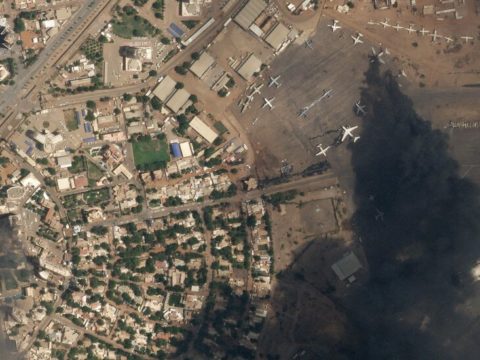
As deaths approach 500, no sign of a slowdown in China.
The death toll from the monthlong coronavirus outbreak has continued to climb in China, rising to 490. New cases have surged by double-digit percentages in the past 11 days, with no sign of a slowdown.
More people have now died in this epidemic than in the severe acute respiratory syndrome, or SARS, outbreak of 2002-3 in mainland China. During that outbreak, 349 people died in the mainland.
The new figures from China’s Health Commission on Wednesday showed that 65 people died on Tuesday and that 3,887 more people had been infected. So far, 24,324 people are known to have been infected.
Health experts say the death toll is likely to rise because of the large number of infections. The mortality rate of the coronavirus, about 2 percent so far, appears to be far lower than SARS, which has a mortality rate of about 10 percent.
Experts warn they still lack enough data to say definitively how lethal the new coronavirus is. Many residents in Wuhan, the epicenter of the outbreak and the capital of Hubei Province, believe the death toll is much higher than the official tally because people with flulike symptoms are being turned away by overstretched hospitals. The health care system in Wuhan is so overwhelmed that many cases have not been diagnosed because of a shortage of testing kits.
The number of people in China recovering from the virus is also rising, suggesting that the treatment plan is working. On Tuesday, 262 people left hospitals nationwide. The number of suspected cases has dropped for two days in a row. Officials said they were tracking 3,971 suspected cases, compared with 5,173 cases the day before.
On Tuesday, health officials released details of the deaths so far, saying that two-thirds of them were men. More than 80 percent were over 60 years old, and they typically had pre-existing health conditions such as cardiovascular diseases or diabetes.
Hubei Province has been hardest hit by the virus, and is home to the bulk of deaths (479) and infections (16,678). Wuhan in particular has borne the brunt of the deaths and infections.
The government said it has put 252,154 people under surveillance.
Looking for the basics? Start here.
What is a coronavirus, and how dangerous is it? Read up on the basics, including its symptoms and how it is transmitted.
How bad could the outbreak be? Here are the six key factors that will determine whether it can be contained.
Where has the virus spread? You can track its movement with this map.
How is the United States being affected? There were 11 confirmed cases as of Tuesday. American citizens and permanent residents who fly to the United States from China are now subject to a two-week quarantine.
What if I’m traveling? Several countries, including the United States, have discouraged travel to China, and several airlines have canceled flights. Many travelers have been left in limbo while looking to change or cancel bookings.
How do I keep myself and others safe? Washing your hands is the most important thing you can do.
A second evacuation of Americans from Wuhan has begun.
The United States has begun its second airlift of American citizens out of China.
“Two planes have departed Wuhan en route to the United States,” the State Department said in a statement Tuesday night.
Little information was immediately available on the planes’ destination.
But it was believed that like the first Americans evacuated from Wuhan, the passengers will be taken to a military base and directed to remain there pending medical tests.
The first evacuees were flown from Wuhan on Jan. 29, and their plane stopped in Anchorage to refuel and for the passengers to be given initial screenings. The Boeing 747 then continued on to March Air Reserve Base in Riverside, Calif.
After traveling to China, some Americans are staying indoors.
As United States officials impose new restrictions on travelers from China, many people who have returned to the country in recent days have hunkered down in their homes to make sure they were not carrying or spreading the disease.
Some were checking in regularly with local public health departments, taking their temperatures at regular intervals and receiving deliveries of food and water. Others were not conferring with the authorities, but choosing on their own to stay indoors, away from work, away from friends and, in some cases, away from everyone.
All were counting down the days since they left China, waiting anxiously to see if symptoms develop — and whether they can get their lives back to normal.
“It’s pretty scary,” said a woman in Massachusetts whose husband and 18-month-old son have been holed up in the family’s basement since returning from China last week.
The woman, a medical researcher who asked not to be named, said her family’s self-imposed quarantine was a necessary step to protect others, especially since she feared her family had traveled on the same flight as a man who was later diagnosed with coronavirus.
“If people are responsible people,” she said, “they are willing to do this.”
10 passengers on a cruise ship in Japan tested positive for the virus.
Ten passengers on a cruise ship quarantined in Yokohama, Japan, have tested positive for the coronavirus, Japan’s health minister said on Wednesday.
The ship, carrying about 3,700 people, arrived in Yokohama on Tuesday, but the authorities did not allow anyone off. An 80-year-old Hong Kong resident who had disembarked earlier in his home city was found to be infected.
In all, 273 passengers were tested for the virus after everyone on board underwent an initial health screening. Twenty-one people were cleared, and officials were awaiting the other results.
The passengers who tested positive were being transported by a Japanese Coast Guard ship to a hospital. The other passengers are to remain quarantined on board the Princess Cruises ship, the Diamond Princess.
Also on Wednesday, the American military, which has a large presence in Japan, said that anyone under its jurisdiction who was returning to the country from China would undergo a 14-day quarantine.
Hyundai suspended production at South Korea car factories.
Hyundai, the world’s fifth-largest carmaker, has said that it was suspending production lines at its car factories in South Korea, one of the first major manufacturers to face severe supply chain issues because of the coronavirus.
Hyundai, which relies on auto parts from China, said in a statement on Tuesday that it had “decided to suspend its production lines from operating at its plants in Korea.”
“The decision is due to disruptions in the supply of parts resulting from the coronavirus outbreak in China,” it added.
Many auto plants in China have shut down because of the virus, including factories run by Hyundai, Tesla, Ford and Nissan. Hyundai plants in South Korea would be the first to shut down lines outside China.
“The company is reviewing various measures to minimize the disruption of its operations, including seeking alternative suppliers in other regions,” a Hyundai spokesman said in an email.
Hyundai has a worldwide network of factories, including plants in Russia, Turkey, the Czech Republic and Montgomery, Ala., which can probably make up for lost production in South Korea.
But the shutdown of some production at its South Korean plants may signal further disruptions at manufacturers that depend on parts from China. The longer that Chinese factories remain shut, the greater the risk of shortages of key components.
Credit: Source link












